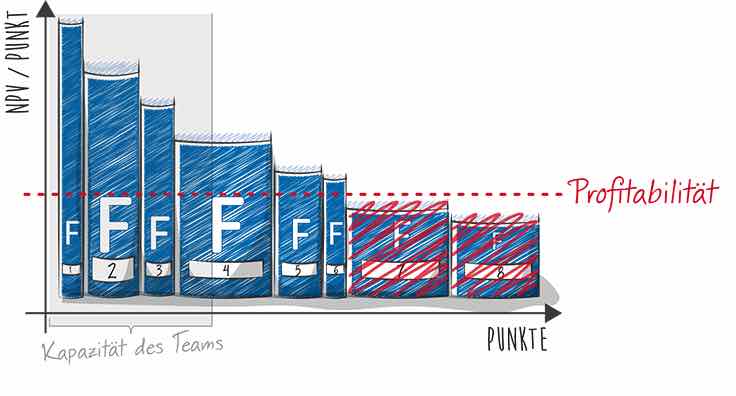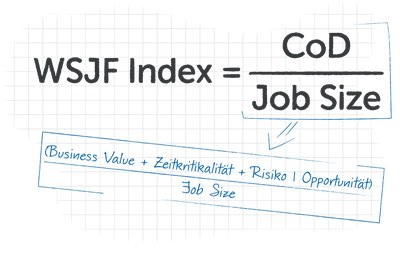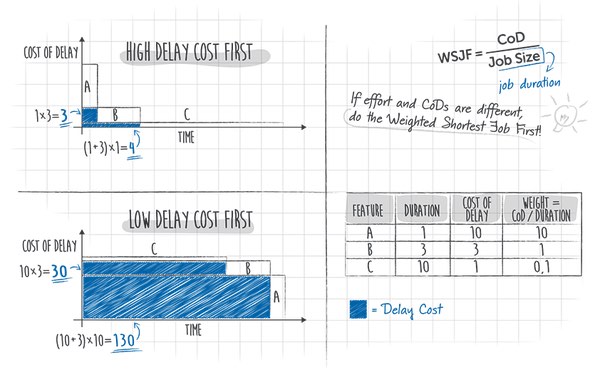How can projects be prioritized?
If you want to limit and thus optimize throughput, you must first prioritize projects. "Stop starting & start finishing" means making a clear statement about what should be done next - and what should not. If you are not able to prioritize, you are costing the company a lot of money. Viewing two tasks as equally important and working on them in parallel means doubling the duration of both tasks. What nobody wants directly happens indirectly: tasks take longer than necessary, which means that value is generated later and they cost more than planned due to additional set-up or training times.
It is therefore very important for managers and decision-makers to make a statement about what is important for the company (portfolio) is the most important thing. Agile methods such as Scrum or Kanban use the relatively prioritized backlog to express this. This product backlog contains everything that is currently known as a requirement for the project or product. Priority always expresses the value that an element generates more or less quickly for the customer. Of course, it can also be an internal customer - the backlog does not differentiate here.
The product backlog is in the Scrum Guide described. However, as this primarily describes the working methods of teams, there are no concrete descriptions for managing a strategic portfolio. Two practices that have proven their worth are the consideration of the cost of delay and the resulting prioritization according to the relatively shortest job (Weighted Shortest Job First, WSJF for short).
Net present value
Another option is to calculate the net present value. This looks at the value that can be achieved by completing a product backlog item, taking into account delay costs and interest effects. These are, for example, estimated revenues from a feature or product. Any expenses that have to be paid are also taken into account. If there are also uncertainty factors, such as inflation, these are factored in using the discount rate.

With this calculation, the entries in the portfolio backlog are evaluated in monetary terms and a clear prioritization of tasks becomes possible.

The net present value takes into account in the prioritization that small product increments are more likely to generate sales due to earlier market entry, which must be compounded in the overall value analysis.
Cost of Delay
In his book "The Principles of Product Development Flow: Second Generation Lean Product Development", Don Reinertsen introduces the concept of cost of delay (CoD) and thus creates a basis for establishing a special, economically relevant form of priority. In simple terms, cost of delay describes what it costs when a company is late to market with a feature, a machine, a product, etc. - in other words, when the value for the customer is generated later than planned or later than required by the market. Following this theory, agile frameworks work with techniques such as agile ways of working that focus companies on bringing products to market quickly in order to generate initial sales and customer feedback as soon as possible.
Weightest Shortest Job First
One prioritization technique that takes this into particular consideration is Weighted Shortest Job First (WSJF): This technique aims to keep delay costs low. There are various ways of calculating this. The Scaled Agile Framework uses the following formula:

Don Reinertsen only uses "value/size". This calculation method also evaluates backlog items, but neither exclusively nor absolutely in monetary terms. Through the relative evaluation of all elements (epics, features, stories), a clear order can also be created in the backlog and this leads to a clear prioritization of the backlog at portfolio level.
One advantage of the technique is that values can be determined using a relative estimate. It is therefore not a question of calculating with absolutely precise amounts in order to be able to make a statement about the priority. The relative evaluation of the elements is sufficient for prioritization. At the beginning, it is determined for each parameter (job size, time criticality, risk/opportunity costs and job size) which element has the relatively smallest share. This is assigned the value 1. All other values are then determined in relation to this. In the end, each entry in the portfolio backlog has an index and the entries can be sorted by size.


WSJF focuses on highly prioritizing benefit packages that quickly generate value and feedback. In addition to the pure market value, the method also takes into account values such as delay and opportunity costs.

WSJF supports the claim to deliver value quickly: By placing the size of a "job" alone in the denominator, comparatively small benefit packages are favored more than average.

Establish a mathematical, communicated basis for determining values. Make it transparent in the organization how the priority is determined in the company.

If a company is not yet very mature in terms of self-determination and empowerment, but you want to take the first steps, think about inheriting the priorities from the portfolio across the levels. Always bear in mind, however, that this will disempower the product owners and other roles at other levels.
This post is part of the Agile Portfolio Management series. The first post in this series is here -> Agile portfolio management
Continue in the next post -> Agile tact on three levels
Note: This text is an article by Sebastian Schneider and Lothar Fischmann that we published on our website in 2018. As this topic is still very popular, we republished this article on our blog when we restructured our website.

Write a comment